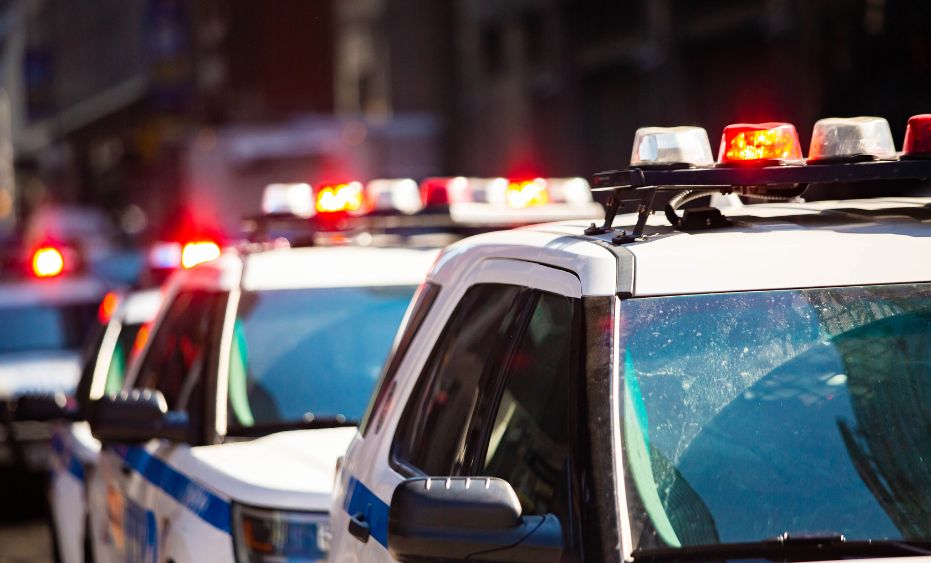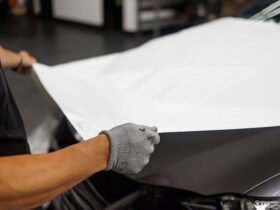In the bustling streets of any city, police vehicles are a familiar yet mysterious presence. We see the flashing lights, the sleek cars, and, more often than not, the heavily tinted windows obscuring the faces inside. But why exactly do police vehicles use such dark tint, often a 5% level that allows minimal visibility?
Police vehicles often use a 5% tint, which allows only 5% of visible light to pass through, making it one of the darkest legal tints.
To answer this is to uncover an intricate balance between safety, strategy, and the silent code of law enforcement.
In the U.S., U.K., and UAE, window tinting laws specify the types of tints and levels of darkness allowed for citizens and often permit law enforcement vehicles to have more flexibility. Here’s a breakdown of tint types commonly used by citizens versus police vehicles:
1. Standard Tint Types for Citizens
- Dyed Window Tint: The most common and affordable, dyed tint uses layers of dye to absorb solar heat and reduce visibility. It’s generally allowed within specific visible light transmission (VLT) limits, typically around 35% to 50% VLT, depending on local laws.
- Metalized Window Tint: Uses tiny metallic particles to block heat and glare, offering a reflective look. Some regions restrict metalized tints due to their reflective nature.
- Carbon Tint: Known for its durability and effectiveness, carbon tint blocks infrared light and UV rays without the metallic shine. It’s legal in many areas as long as it meets the VLT requirements.
- Ceramic Tint: A premium option, ceramic tint offers maximum heat reduction and UV protection without interference with electronics. While more expensive, it’s generally allowed within local VLT standards and offers high performance and clarity.
- Hybrid Tint: Combines dyed and metalized tints, offering a balance of cost-effectiveness and performance. Its VLT limit varies depending on location.
2. Tint Types and Levels Commonly Used by Police Vehicles
- 5% Tint (Limo Tint): Used on police vehicles for increased privacy, this tint allows only 5% of light to pass through. It’s primarily used for tactical and undercover vehicles or on patrol vehicles in certain high-risk areas. In most regions, civilians are restricted from using 5% tint, but law enforcement vehicles are often exempt.
- Security Tints: Often a mix of ceramic and metalized materials, these tints provide both heat rejection and enhanced shatter resistance, crucial for police safety.
- One-Way Mirror Tint: Sometimes used on undercover or tactical police vehicles, mirror tinting gives a reflective surface on the outside while maintaining visibility from the inside. This type of tint is heavily regulated or prohibited for civilian use in many regions.
- Anti-Shatter Film: While not a traditional tint, anti-shatter film is applied to police vehicles to protect officers from shattered glass in the event of an attack. It’s sometimes combined with tinted glass to provide both privacy and safety.
Legal Differences Between Citizens and Police Tinting
- For Citizens: Civilian tinting must comply with VLT limits, often set around 35% to 50% for side and rear windows, and usually requires clear front windshields. The level of darkness, reflective properties, and types of tint are all regulated to ensure driver visibility and public safety.
- For Police: Law enforcement vehicles are often exempt from standard tint regulations, especially on patrol and tactical vehicles. The exemptions allow for darker tints to protect officers, conceal equipment, and assist with undercover work.
In the U.S., window tinting laws are established at the state level, leading to variations across the country. While civilian vehicles are subject to specific tinting restrictions to ensure visibility and safety, police vehicles are frequently granted exemptions from these regulations. For instance, in Florida, police vehicles are permitted to have darker tints than those allowed for civilian vehicles.
In the UK, the law mandates that the front windscreen must allow at least 75% of light through, and the front side windows must permit at least 70% light transmission. These regulations apply to all vehicles, including those used by law enforcement. However, certain operational vehicles, such as unmarked police cars used for covert operations, may be granted exemptions to these rules to facilitate their specific functions.
In the United Arab Emirates (UAE), police vehicles are permitted to have tinted windows. While civilian vehicles are subject to specific tinting regulations – allowing up to 50% tint on side and rear windows, with no tint on the front windshield – law enforcement vehicles often receive exemptions to these rules.
Here’s why this level of tint is commonly used:
- 1. Enhanced Officer Safety: Police vehicles are typically outfitted with specialized equipment, including weapons, radios, and other law enforcement tools. The 5% tint conceals this gear, reducing the likelihood of theft or tampering.
- 2. Concealing Sensitive Equipment: When conducting surveillance or covert operations, officers often need to remain unseen. The 5% tint allows officers to monitor situations discreetly, helping them to carry out operations without alerting suspects.
- 3. Effective for Surveillance: When conducting surveillance or covert operations, officers often need to remain unseen. The 5% tint allows officers to monitor situations discreetly, helping them to carry out operations without alerting suspects.
- 4. Deterring Confrontation: The dark tint makes it hard for people outside to discern the number of officers inside or their actions, which can reduce the risk of direct confrontations or ambushes, especially in vehicles assigned to high-crime areas.
For police officers, each moment on duty can hold unforeseen danger. Dark tints serve as a protective shield, turning the vehicle into a fortress of sorts. The 5% tint—the darkest legal level—allows only 5% of light to enter, concealing not just the identity of those inside but their every move.
Imagine a scenario: an officer in a tinted vehicle patrolling a known crime hotspot, each moment tense with the potential for confrontation. The dark windows act like armor, shielding officers from the probing eyes of those who may have malicious intentions. As a result, tint becomes an unsung hero, providing the security and anonymity that officers need to navigate dangerous areas.
The 5% tint does more than just protect; it turns the vehicle into a silent partner in operations. By obscuring the vehicle’s interior, tinted windows allow police to operate covertly, maintaining an air of unpredictability.
Police Vehicles
12 Police Vehicles Featured you Need to know
Police vehicles are equipped with specialized features to support law enforcement duties effectively and safely. Here’s a rundown of common features in police vehicles:
- 1. High-Performance Engine and Suspension
- 2. Emergency Lighting and Sirens
- 3. Two-Way Radio and Communication Systems
- 4. Onboard Computer System (Mobile Data Terminal)
- 5. In-Car Video and Surveillance Cameras
- 6. Protective Partition
- 7. Secure Rear Seating
- 8. Automatic License Plate Recognition (ALPR)
- 9. Weapon and Equipment Storage
- 10. Spotlights and Additional Lighting
- 11. Heavy-Duty Brakes and Tires
- 12. Bulletproofing (in Specialized Vehicles)
The cost of police vehicles
The cost of police vehicles varies significantly based on their type, purpose, and the specific equipment installed. Standard patrol cars, such as the Ford Police Interceptor Utility, typically range from $35,000 to $45,000. This price includes essential law enforcement features like reinforced structures, specialized lighting, and communication systems.
Which country have most expensive police vehicles?
The United Arab Emirates, particularly Dubai, is renowned for having the most expensive police vehicles globally. The Dubai Police Force boasts a fleet of luxury supercars, including a Bugatti Veyron valued at approximately $1.6 million. This vehicle is among the most expensive police cars worldwide and serves more as a symbol of the city’s wealth and modernity than for traditional law enforcement duties.
Additionally, the fleet includes other high-end vehicles such as the Aston Martin One-77, priced at around $2 million, and the Lykan Hypersport, valued at $3.4 million. These vehicles are primarily used for promotional purposes and to enhance the public image of the police force.












